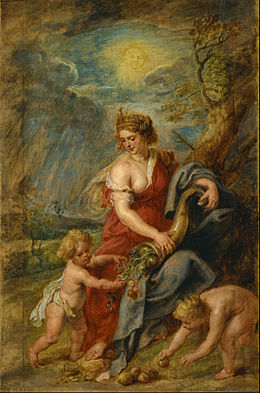|
Greek Coin of Seleukid Kingdom
Alexander II Zabinas – Reigned: 128-123 B.C.
Bronze 21mm (7.48 grams) Antioch on the Orontes mint
Reference: Sear 7127; HGC 9, 1164; SC 2237
Radiate and diademed head of Alexander II right.
ΒΑΣΙΛΕΩΣ ΑΛΕΞΑΝΔΡΟΥ, either side of double-cornucopia bound with diadem.
Claiming to be an adopted son of Alexander Balas, Zebina rebelled against Demetrios II with the backing of Ptolemy VII of Egypt. Five years later he was defeated by the forces of Cleopatra and her son Antiochos VIII.
You are bidding on the exact item pictured, provided with a Certificate of Authenticity and Lifetime Guarantee of Authenticity.
The cornucopia (from Latin cornu copiae) or horn of plenty is a symbol of abundance and nourishment, commonly a large horn-shaped container overflowing with produce, flowers or nuts. The horn originates from classical antiquity, it has continued as a symbol in Western art, and it is particularly associated with the Thanksgiving holiday in North America.

Allegorical depiction of the Roman goddess Abundantia with a cornucopia, by Rubens (ca. 1630)
In mythology
Mythology offers multiple explanations of the origin of the cornucopia. One of the best-known involves the birth and nurturance of the infant Zeus, who had to be hidden from his devouring father Kronus. In a cave on Mount Ida on the island of Crete, baby Zeus was cared for and protected by a number of divine attendants, including the goat Amalthea (“Nourishing Goddess”), who fed him with her milk. The suckling future king of the gods had unusual abilities and strength, and in playing with his nursemaid accidentally broke off one of her horns, which then had the divine power to provide unending nourishment, as the foster mother had to the god.
In another myth, the cornucopia was created when Heracles (Roman Hercules) wrestled with the river god Achelous and wrenched off one of his horns; river gods were sometimes depicted as horned. This version is represented in the Achelous and Hercules mural painting by the American Regionalist artist Thomas Hart Benton.
The cornucopia became the attribute of several Greek and Roman deities, particularly those associated with the harvest, prosperity, or spiritual abundance, such as personifications of Earth (Gaia or Terra); the child Plutus, god of riches and son of the grain goddess Demeter; the nymph Maia; and Fortuna, the goddess of luck, who had the power to grant prosperity. In Roman Imperial cult, abstract Roman deities who fostered peace (pax Romana) and prosperity were also depicted with a cornucopia, including Abundantia, “Abundance” personified, and Annona, goddess of the grain supply to the city of Rome. Pluto, the classical ruler of the underworld in the mystery religions, was a giver of agricultural, mineral and spiritual wealth, and in art often holds a cornucopia to distinguish him from the gloomier Hades, who holds a drinking horn instead.
Alexander II Zabinas, ruler of the Greek Seleucid kingdom, was a counter-king who emerged in the chaos following the Seleucidian loss of Mesopotamia to the Parthians. Zabinas was a false Seleucid who claimed to be an adoptive son of Antiochus VII Sidetes, but in fact seems to have been the son of an Egyptian merchant named Protarchus. Antioch, Apamea, and several other cities, disgusted with the tyranny of Demetrius, acknowledged the authority of Alexander. He was used as a pawn by the Egyptian king Ptolemy VIII Tryphon, who introduced Zabinas as a means of getting to the legitimate Seleucid king Demetrius II, who supported his sister Cleopatra II against him in the complicated dynastic feuds of the latter Hellenistic dynasties.
Zabinas managed to defeat Demetrius II, who fled to Tyre and was killed there, and thereafter ruled parts of Syria (128 BC-123 BC), but soon ran out of Egyptian support and was in his turn was defeated by Demetrius’ son Antiochus VIII Grypus.
Zabinas fled to the Seleucid capital Antiochia, where he plundered several temples. He is said to have joked about melting down a statuette of the goddess of victory Nike which was held in the hand of a Zeus statue, saying “Zeus has given me Victory”. Enraged by his impiety the Antiochenes cast Zabinas out of the city. He soon fell into the hands of robbers, who delivered him up to Antiochus, by whom he was put to death, in 122 BC.
The name “Zabinas” means “the purchased slave”, and was applied to him, deprecatingly, in response to a report that he had been bought by Ptolemy as a slave. For reasons unknown, Alexander II was the only late Seleucid not to use epithets on his coins. Several of his coins are extant.
Preceded byy
Antiochus VII Sidetes |
Seleucid King
128–123 BC |
Succeeded by
Antiochus VIII Grypus
and
|
|












